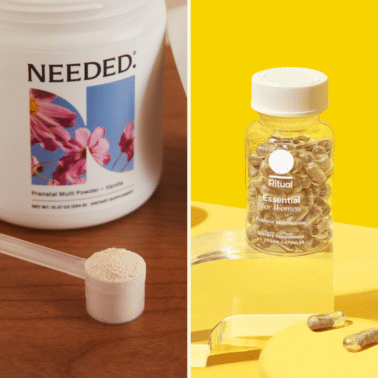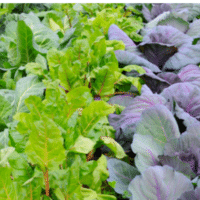How do you start a garden? Is there an ideal time to plant? Should you plant seeds or sprouts? What’s the maintenance like? We’re diving into all of this (and more!) with our beginner’s guide to gardening!

Gardening can be such a relaxing pastime done from the comfort of your own home (here are more favorite at-home activities!) When it comes to gardening though, there’s a lot to learn, but don’t be intimidated…I’m learning right alongside you (we’ve got this!) When I think about a backyard garden, I think back to a few years ago when my in-laws had a HUGELY successful vegetable garden harvest. I’m talking bell peppers, tomatoes, cucumbers, jalapenos, beets, asparagus, and so much more. And by successful, I mean that their entire cul-de-sac of neighbors would knock on their door each night to ask for some produce for their dinner side salad…and there was ALWAYS enough!
The best time to get your garden started varies based on where you live and depends largely on the weather. For example, you’ll need to get started earlier in the year if you live in Texas and later if you live in, say, Colorado or another cold-weather state. Plant your garden after the last freeze to keep your plants cozy and thriving.
Beginner Tips for a Bountiful Harvest
Gardening takes patience, hard work, and consistency, and we’re here to help you with that. Here are our BEST tips for the gardening novices of the world!
Tip 1: Find the best spot for your garden.
This is a BIG one! The spot you choose for your garden can make all the difference between a flop (though some years that just happens) and a wildly successful harvest. The amount of water + sunlight a plant gets is key to its survival, so when scouting out the perfect spot, you’ll need to pay special attention to the amount of sun your prospective locations get each day. Here are the best fruits and veggies for different amounts of sun exposure:
Full Sun (6-8 hours of direct sunshine)
- Cucumbers
- Squash
- Melons
- Eggplant
- Tomatoes
- Peppers
- Beans
Partial Sun (4-6 hours of direct sunshine)
- Broccoli
- Carrots
- Radishes
- Potatoes
- Turnips
- Beets
Full Shade (2-4 hours of indirect sunshine)
- Kale
- Arugula
- Lettuce
- Spinach
- Mustard Greens
- Parsley
- Cabbage
- Scallions
Tip 2: Don’t bite off more than you can chew.
Gardening is tough and takes a lot of maintenance, so our recommendation is to start small and work your way up each season. How small are we talking? A 4-foot square plot is a great starter size. One of the biggest mistakes that beginner gardeners make is planting ALL OF THE THINGS (we get it, it’s tempting!), and then (very overwhelmingly) realizing that they just can’t keep up with it all. Starting small allows you to really focus in on your plants and the maintenance they require, resulting in some really yummy, fresh homegrown goods and a more confident gardener.
Tip 3: Give your soil some love.
Strong roots = strong plants. What can you do to ensure that your plants have the strongest roots possible? Give your soil some love! We like to keep things as natural as possible over here, so when it comes to prepping your soil, we think using compost is the best option. Compost, which is essentially decomposed organic matter, creates nutrient-rich soil, keeps moisture locked into the soil, and helps to control weeds. While you can buy bagged compost, it’s also super easy to make yourself; start simple – grab an odor-locking compost bin and throw in fruit/vegetable trimmings, eggshells, coffee grounds, and tea bags as you use them. Hold on to any wood scraps, dry leaves, and old newspapers and add those to your compost bin too – it’s good to have an equal mix of moist matter (think: the stuff you’re collecting in your kitchen) and dry matter. Over time, your waste will turn into soil – to aid in this, give your compost a “stir” every week or two. Once your compost is broken down into soil, you can add it to your garden by either sprinkling on top (if your garden is already planted and established), or incorporating it into the soil (do this as you’re preparing to plant).
 Tip 4: Buy your plants (at least to start).
Tip 4: Buy your plants (at least to start).
Most vegetables need to be started from seed inside before they’re sturdy enough to plant outside. If you aren’t a beginner, this may not seem like a daunting task and these starter trays and fruit and vegetable seed packs are perfect for you. If you are a beginner though (as you likely are if you’re reading a beginner’s guide to gardening!), allowing someone else to do the early growing for you may be the way to go for your first-ever garden. Check with your local greenhouses and nurseries to see what they have available. Most have a plentiful selection!
Tip 5: Water often.
Say it with me, “WATER OFTEN!” Like mentioned before, gardening takes some real commitment and consistency. Your plants depend on a few things for success (soil, sunlight, and water), and the watering part is almost completely up to you to fulfill (save for the occasional rain shower). If you can, water early in the morning before the sun has a chance to heat things up and expedite the evaporation process. Watering during the evening is a good option too. As you’re watering your garden, pay attention to what exactly you’re watering – you’ll want to aim to water the soil, not the leaves of the plants. You’ll also want to completely saturate the soil so that it’s wet 3-6 inches below the surface about 5 times a week.
Tip 6: Harvest your garden daily.
Once you’re starting to see the fruits of your labor (quite literally!), it’s important to check on your harvest daily and pull any ripe, ready-to-eat veggies right away. Harvesting often encourages the plant to continue producing. We recommend checking on your garden every evening – take a basket with you, and start collecting!
Tip 7: Watch out for garden pests.
There are a few things that you can do to help reduce the chances of your plants falling prey to insects and other garden pests. First, as mentioned before, make sure that you’re watering the soil and not the leaves of your plants, and do it first thing in the morning if you can. Watering too late and in the wrong places (plant leaves), results in damp leaves during the night which can be fungus-promoting. Other ways to fight against garden pests are to weed often, keep your garden clean, and pull off infested plant leaves as soon as you see them. Lastly, consider buying some ladybugs from your local nursery – they can do wonders in keeping your garden healthy!
To all the beginner gardeners out there: we hope you feel more confident in starting a garden of your own after reading our Beginner’s Guide to Gardening…you’ve got this!

 Tip 4: Buy your plants (at least to start).
Tip 4: Buy your plants (at least to start).














Great article
So glad you enjoyed it, Narelle!